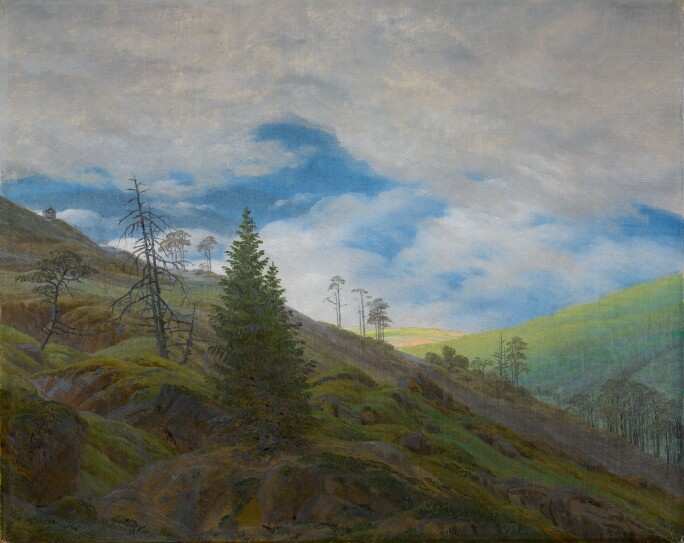S otheby’s sale of 19th Century European Paintings is led by a rare selection of German Romantic works including two works by the father of German Romanticism Caspar David Friedrich, the neoclassical landscape painter Joseph Anton Koch, as well as works by Wilhelm von Kobell, Carl Spitzweg and Philipp Otto Runge. Here we explore the history of this important artistic movement which originated towards the end of the eighteenth century.
1. History of the term
Romanticism itself was not a homogenous movement but rather a complex phenomenon. Instead of being an art-historical term, Romanticism implies a set of social attitudes which emerged in the literature, music, philosophy and art of the time. Romanticism, along with Classicism and Realism, developed from the ideology of the Enlightenment combined with “Sturm und Drang” (“Storm and Drive”, a proto-Romantic movement in German literature and music which took place between the late 1760s and early 1780s).
2. Development of German Romanticism
Two key trends dominated Romantic art: early Romantic painting originated in the Protestant North; South Germany was the home of the Lukasbrüder (Brotherhood of St Luke), who later became known as the Nazarenes (alluding to primitive Christians). The rise in popularity of and demand for Realist and Impressionist works of art and literature limited Romanticism to painting on a local level.
3. Dominant Characteristics
Older romantics, such as the Schlegel brothers and Novalis, tended toward “Sturm und Drang”, which sought depth and profound emotion. For them, Romanticism was not a reaction against Classicism; nor did it ignore Classicism’s achievements – rather, it supplemented and amplified them, placing stronger emphasis on the realm of the unconscious. Fritz Strich defined Classicism as innately calm; it insisted upon completeness and perfection. Romanticism, contrariwise, was intrinsically restless and indefinite; longing had neither aim nor limit. Subsequently, borderlines between the arts became obscured, and art, literature and music merged. Creative minds of the time saw tones, colours and words all as different forms of the same language.
4. Nature and the Divine
Romanticism crucially also maintains that art cannot be learned; it emerges from divine inspiration. The artist’s role is mediator between the creative and the divine. Nature was considered to be the visible spirit, the evidence of the divine in the absence of an image of God himself. The romantic landscape artist was charged with the responsibility of contemplating nature and its spirit and then replicating it in art.
5. Early Romanticism
Early Romantic painting was rooted in the Protestant north and centred in Dresden, home to Caspar David Friedrich and Philipp Otto Runge (the two names most notably associated with this branch of Romanticism). Romantic painting here was characterised by silent reflection and introspection. Landscape became its high point and principal subject matter. The northern Romantics portrayed landscape as an emblem of divine world order of which man is a mere component – man stands apart from nature and longs to immerse himself in it, but this is something he can do solely in his imagination, not in reality. These artists viewed man as an individual who contemplates and feels more than he calculates and thinks and whose chief desire was to become a spiritual and intellectual being. They took inspiration from the work of Romanticists such as Novalis, the Schlegel brothers, Schubert and Weber.
6. The Nazarenes
The Lukasbrüder in Germany’s Catholic south were a group of artists who left the academy in Vienna to move to Rome. Their work was principally figural, endowed with religious content, and influenced by the Middle Ages and the Old Masters. This they saw as their own contribution to the reformation of German society. In the medieval spirit, they participated in communal work; a key example of this are the frescoes of 1816-17 in the palazzo of the Prussian consul in Rome, named Casa Bartholdy, which illustrate the story of Joseph. There were also several landscape painters amidst Germany’s southern art scene, such as Joseph Anton Koch whose paintings depict nature as symbolic of freedom and eternal order, and other Viennese artists who popularised the landscape around Salzburg and Berchtesgarden.
7. The Last Romantics
After 1830, Romanticism was no longer so significant in the progression of German art. The industrial bourgeoisie favoured art which evoked their present reality in place of the high ideals of the past. Key artists from this time include Ludwig Richter and Moritz von Schwind. Both artists’ work incorporated Nazarene beauty blended with folklore. Richter, who had been a student of Koch, chose to represent in his work a fusion of the figural and the pastoral. Von Schwind was greatly influenced by contemporary poetry; he looked to tales and legends and the chivalry of the middle ages for inspiration and so earned his nickname “poet-painter”.







